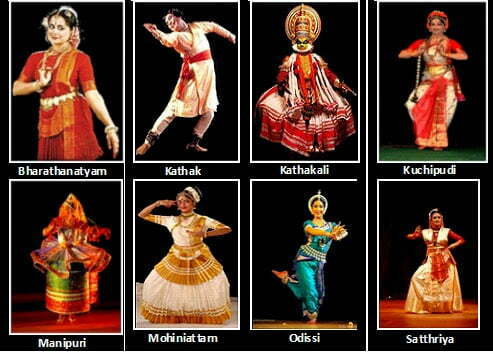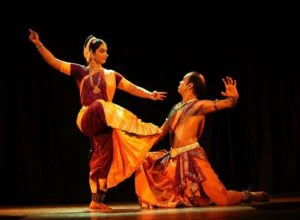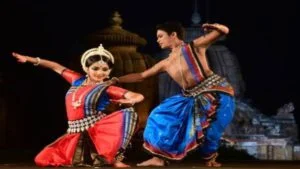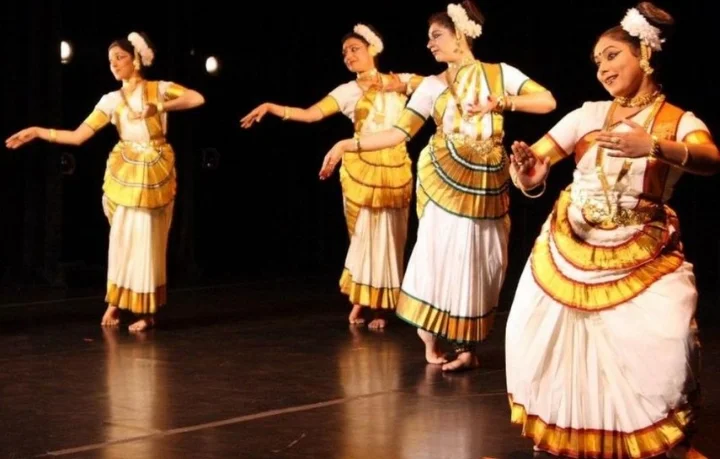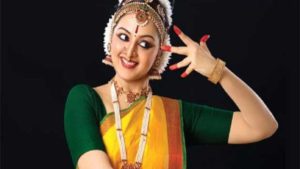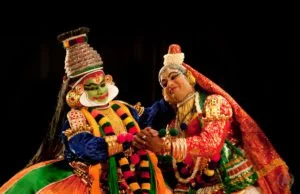What is Mohiniattam Dance?
Mohiniattam, the dance of the enchantress is a semi-classical dance form with its origins in the state of Kerala, situated in southwestern India. The Hindu god Vishnu had incarnated as the enchantress and seductress Mohini, this dance is in honor of her. According to Hindu mythology, Mohini appeared when the ocean was churned by the Devas and Asuras for the Elixir of Immortality. However, when the Elixir emerged the latter attempted to snatch it. That is when Vishnu appeared in the form of Mohini and cast a spell of enchantment on the Asuras. Stunned by her alluring beauty and charm the Asuras lost their senses and the Devas carried away the elixir. And thus, saved the universe from destruction. The myth of Mohini forms the core of all mohiniattam performance.

Mohiniattam’s entrancing grace makes it distinctively different from all other dance forms of India. In its present form, mohiniattam is hardly two hundred years old. The dance form has undergone, stylistic changes before it assumed its present stage. Traditions are never stagnant; they evolve with time, by responding to aesthetic concepts and social tastes of a changing audience. Mohiniattam is a solo performance by female artists. The dance emotes a play through dancing and singing where the song is customarily in Manipravala, which is a mix of Sanskrit and Malayalam. Additionally, the dancer herself or the vocalist performs the recitation in Carnatic music style.

Podium School brings to their readers all there is to know about this beautiful dance form Mohiniattam.
Mohiniattam Origin
Mohiniattam dance form evolved from the state of Kerala which also has an association with the old tradition of Lasya style of dancing. The temple sculptures are the earliest manifestations of mohiniattam. The poses in this dance form are also palpable from the various feminine sculptures that adorn the 11th century Vishnu temple at Trikodithanam, and the Subramanya temple. Malayalam bards and playwrights incorporated the Lasya theme ; a fact evident from the text-based records starting from the 12th century. The 16th century book titled ‘Vyavaharamala’ written by scholar, poet, author, and astrologer Mazhamangalam Narayanan Nambudiri is the first known book mentioning mohiniattam in connection with a payment due to a mohiniattam dancer.
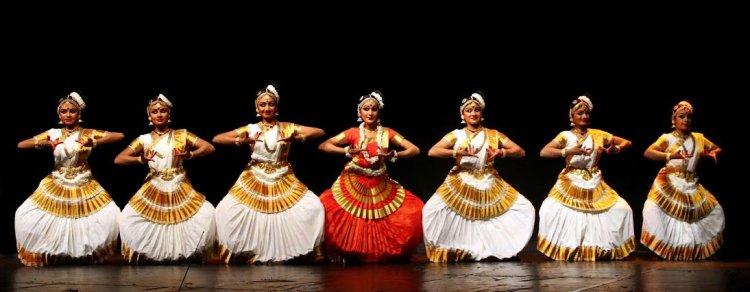
The earliest mention of mohiniattam occurs in a 16th century legal treatise. However, the dance form did not begin to take solid shape until the 18th century. In the mid-19th century Swati Thirunal the king of Travancore revived mohiniattam. By the turn of the 20th century, the dance had again fallen into disfavor due to the presence of erotic art elements in the dance form. The dance provoked moral impropriety some said.
In 1930 poet Vallathol Narayana Menon renewed interest in mohiniattam by including it in the program of his Kerala Kalamandalam. Since then, the dance has been the subject of scholarly research. It has also been a part of the curriculum of other art schools and universities across India.
Mohiniattam Repertoire
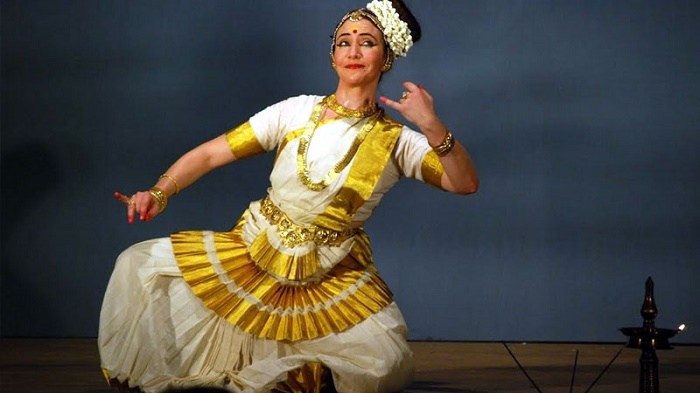
Traditionally the repertoire of Mohiniattam follows two performance categories; ‘Nritta’ and ‘Nritya’ mentioned in ‘Natya Shastra’. It follows a more graceful, gentle and feminine form of dancing and displays excellence in ‘Ekaharya Abhinaya’.
‘Nritta’ is a technical performance; where the dancer presents pure dance movements giving stress on speed, form, pattern, range, and rhythmic aspects without any form of enactment or interpretive aspects. In ‘Nritya’ the dancer communicates a story, through expressive gestures and slower body movements harmonized with musical notes. Natyam is a group communicating a play through dance acting. Mohiniattam’s repertoire sequence includes an invocation or Cholkettu, Jatisvaram, Varnam, Padam, Tillana, Shlokam and Saptam.
Mohiniattam Costumes
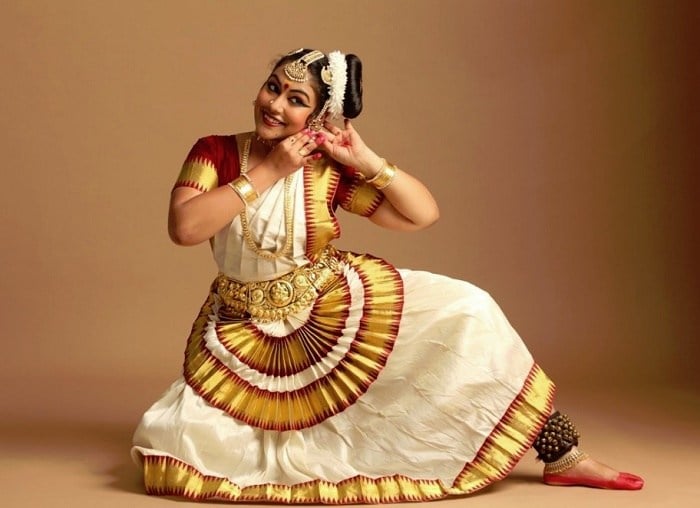
The dancer wears a white or off-white plain sari embellished with gold colored brocade embroidered in its borders complimented with a matching choli or blouse. The front part of the saree from the waist is adorned with pleated cloth having concentric golden colored bands. This embellishment not only lets the artist perform her spectacular footwork flexibly but also highlights it, making it visible from a distance. The dancers wear a golden belt around their waist as well.
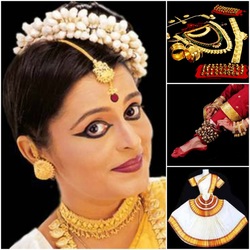
Jewelry adorns the head, hair, ears, neck, wrists, and fingers. Musical anklets called ghungru made of leather straps with small metallic bells attached to it are wrapped in the ankles. These produce rhythmic sound while the dancer showcases excellent footwork. To highlight gestures of hands, feet, and fingers; for highlighting aalta red-colored natured dyes are used. The face is usually painted with bindi on the forehead. The lips are vividly colored red and eyes are lined prominently to make the eye movements more visible. The hair is tied typically on left side of the head, in tight round chignon hairstyle and decorated with flowers, usually jasmine, around the tight bun.
Mohiniattam Music

Different rhythms and lyrics make up the vocal music of this art. However, many of the compositions performed in this dance form are in Manipravala; which is a mix of Sanskrit and Malayalam language while the music style is Carnatic. Instruments played during a Mohiniattam performance usually comprises of Kuzhitalam or cymbals; Veena; Idakka, an hourglass-shaped drum; Mridangam, a barrel-shaped drum with two heads; and flutes.
Historically, the ensemble included a toppi maddalam (barrel drum) and a veena (long-necked lute). Presently though, mridangam (double-headed drum) has replaced the toppi maddalam; a violin substitutes for the veena; the ensemble includes a vocalist; and dancers often also sing.
Final words on Mohiniattam
In today’s times, mohiniattam continues to evolve through innovation and experimentation. It however has retained its essential spirit of seductive grace; which has been garnering audiences everywhere, with efforts from a very few dedicated artistes and cultural institutions.
Although, there is still much more to explore, discover and draw from the hidden treasures of other traditional forms of Kerala, keeping it dynamic and alive – classical in its grandeur and style. Please visit our website to read more on other classical dance forms of India.
Share with your friends

